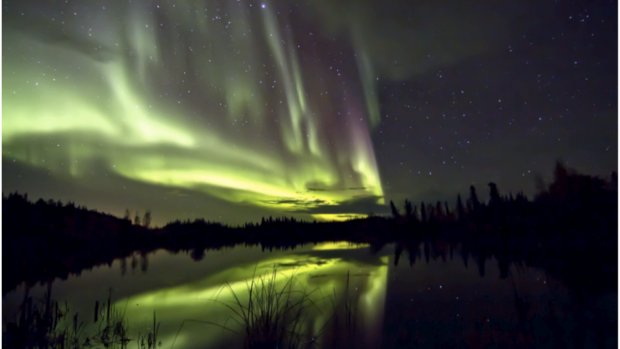

https://ksltv.com/535135/how-to-see-the-northern-lights-sighted-recently-in-utah-skies/


| |||||||
|
A lot of sunspots!!

Space Weather Prediction Center
National Oceanic and Atmospheric Administration
https://www.almanac.com/solar-cycle-25-sun-heating
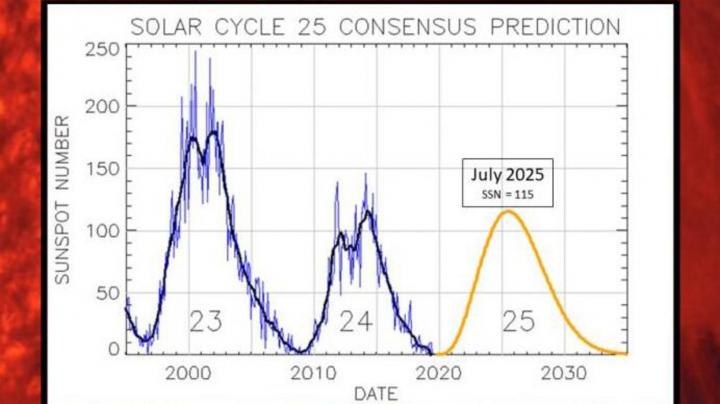
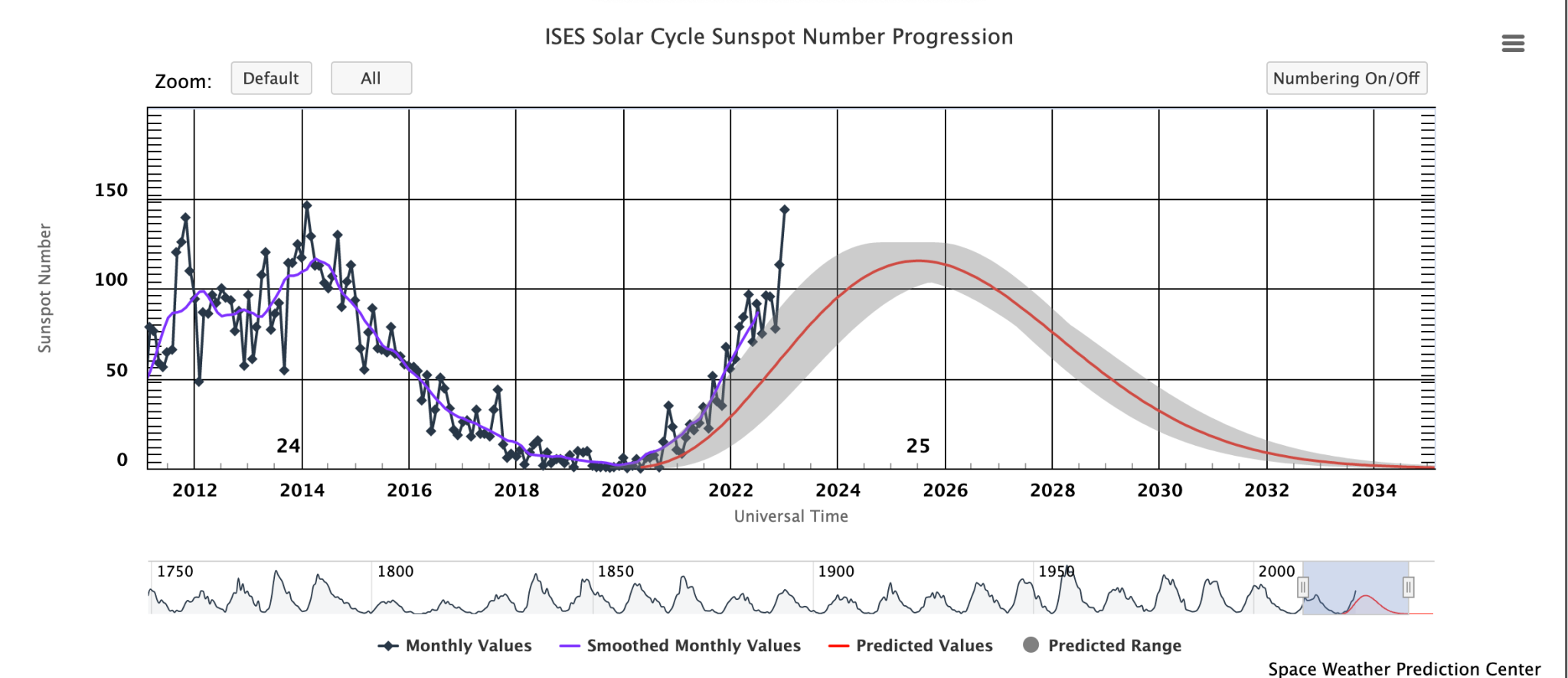
as you can tell from the 2nd graph, the number of sunspots has suddenly and unexpectedly spiked much higher and is greatly exceeding all forecasts.
this appears to be ending the period of much lower sunspots which was causing a weak solar wind and higher amounts of cosmic rays.
you can see on the first graph, the huge drop in sunspots from solar cycle 23 to 24.
some speculated that we were at least experiencing another Dalton minimum and possibly on the way to a Maunder Minimum, when the sun was almost spotless for numerous cycles.
the last several months of sunspots ramping up are obliterating those theories!
More on geomagnetic storms, which will be increasing and speculation on impacts, including climate change when back in my office.
published
The powerful solar storm supercharged auroras as far south as Colorado and New Mexico.
https://www.space.com/strongest-solar-storm-nearly-6-years-surprises-forecasters
https://www.swpc.noaa.gov/phenomena/geomagnetic-storms

https://en.wikipedia.org/wiki/Geomagnetic_storm
A geomagnetic storm, also known as a magnetic storm, is a temporary disturbance of the Earth's magnetosphere caused by a solar wind shock wave and/or cloud of magnetic field that interacts with the Earth's magnetic field.

Artist's depiction of solar wind particles interacting with Earth's magnetosphere. Sizes are not to scale.
Magnetosphere in the near-Earth space environment.
Jean made this post on nuclear EMPs over a month ago and I quickly followed up with pasted copies of previous threads on CMEs but totally missed the opportunity to appreciate THE CURRENT REALITIES above that existed at that time. I wasn't even following the sunspots until this thread.
This is huge!
Previous:
THE EFFECTS OF A NUCLEAR EMP
Started by 12345 - Feb. 13, 2023, 1:04 p.m.
https://www.marketforum.com/forum/topic/93075/
+++++++++++++++
Previous, related discussions from natural events(CMEs).
The last thread has the most info.
New Sunspot may Hurl Dangerous Solar Flare at Earth Started by metmike - Oct. 3, 2022, 3:15 p.m.
https://www.marketforum.com/forum/topic/89419/\\
Geomagnetic storm coming
Started by metmike - Oct. 30, 2021, 2:30 a.m.
https://www.marketforum.com/forum/topic/76828/
GEOMAGNETIC STORM, SLIGHTLY DELAYED https://www.marketforum.com/forum/topic/76036/
The Carrington Event
12 responses |
Started by metmike - Aug. 28, 2021, 11 p.m. https://www.marketforum.com/forum/topic/74346/
During the peak of the previous cycle 24, we were all wondering what was going on:
The Essential Guide to Astronomy
The Weakest Solar Cycle in 100 Years By: Monica Young July 24, 2013
https://skyandtelescope.org/astronomy-news/the-weakest-solar-cycle-in-100-years/
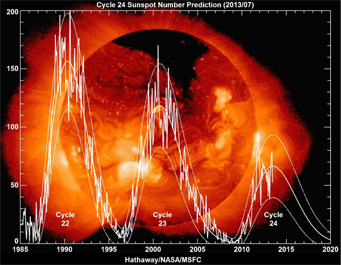
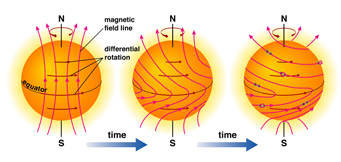
The Sun rotates faster at its equator, which stretches the magnetic field lines around the solar surface.
© Addison Wesley
A well-behaved Sun flips its north and south magnetic poles every 11 years. A cycle starts when the field is weak and dipolar—basically, a giant bar magnet. But the Sun’s rotation is faster at its equator than at its poles, and this difference soon stretches the field lines like distended rubber bands around the solar surface. Frenetic activity ensues, with magnetic tangles producing sunspots, prominences, and sometimes flares and plasma explosions. All of that dies down when the Sun-wide magnetic field lines finally snap into simpler configurations, re-establishing the dipole field and beginning the next cycle.
The Sun has been doing all of that, just to a lesser degree. “Not only is this the smallest cycle we’ve seen in the space age, it’s the smallest cycle in 100 years,” says Hathaway, who took part in the Solar Cycle 24 Prediction Panel back in 2007.
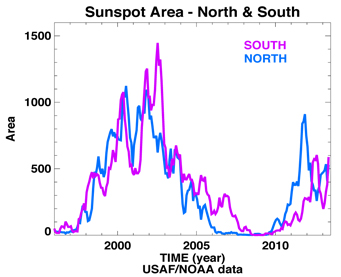
The current cycle isn't just weak. Starting in 2006, the Sun's poles became asymmetric, with the south pole lagging behind the north for the past 7 years. Asymmetric poles are common enough, but they usually synchronize within a year or so.
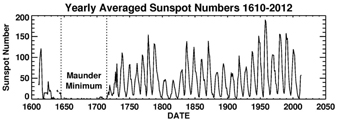
Cycle 24 is the weakest cycle in 100 years. This might be part of a centennial tapering of magnetic activity known as the Gleissberg cycle.
It’s possible that, weak and weird as it is, Cycle 24 is still part of the Sun’s normal variation, even if it’s one of the weakest cycles yet recorded.
Penn offered another, more catastrophic option: the sunspot cycle might die altogether. His team uses sunspot spectra to measure their magnetic fields, and his data show a clear trend: the magnetic field strength in sunspots is waning.
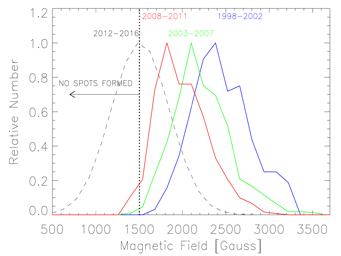
Penn's research shows that sunspots' magnetic field strength is declining over time. Sunspots can only form if the magnetic field is greater than around 1,500 Gauss, so if the trend continues, we could be headed for a time where no spots appear on the Sun's surface.
M. Penn
“If this trend continues, there will be almost no spots in Cycle 25, and we might be going into another Maunder Minimum,” Penn states. The first Maunder Minimum occurred during the second half of the 17th century. Almost no spots were seen on the Sun during this time, which coincided with Europe’s Little Ice Age.
++++++++++++++++++++
Obviously the "almost no spots in Cycle 25" speculative theory is dead!
March 27, 2023
https://earthsky.org/sun/sun-activity-solar-flare-cme-aurora-updates/
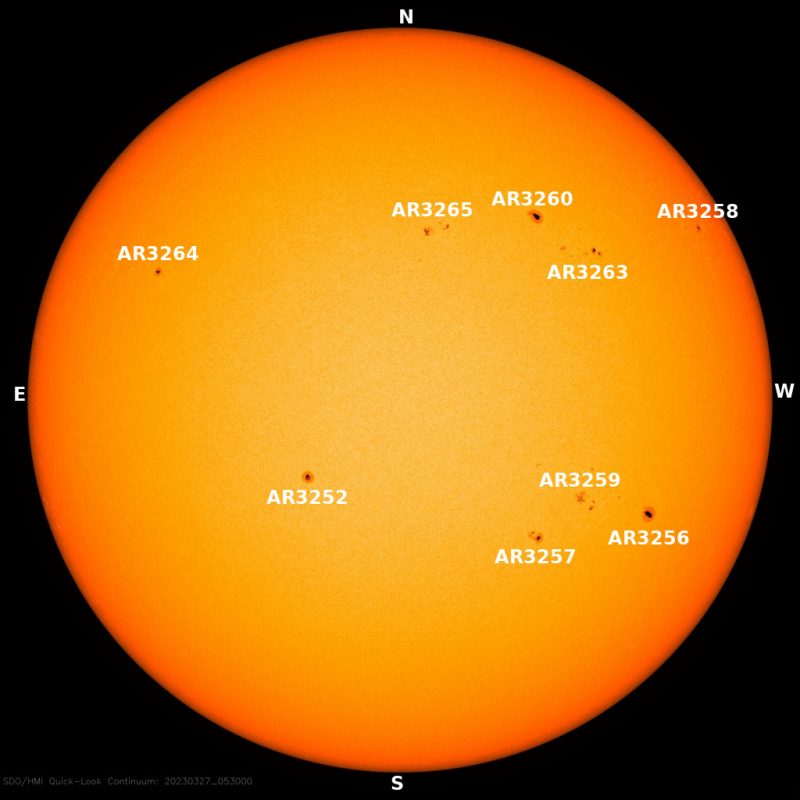
Why only these two bands? The answer is … we don’t entirely know. The full details aren’t fully understood. We do know that – because of the way magnetic fields inside of the sun are formed – when they become concentrated, they rise to the visible surface giving us sunspots. Over the solar cycle, the sunspots are basically confined to bands between 0 and 30 degrees latitude. As the new cycle begins, the sunspots form near 30 degrees. And then as the cycle progresses they move towards the solar equator (0 degrees). This cycle then starts all over again. If you make a graph of the location of the sunspots over time, they form a pattern that resembles butterfly wings. Hence, the name the solar butterfly diagram. The sun is an exciting star and holds many mysteries that we’re just beginning to understand. Stay tuned for more sun fun!
Last 24 hours: Sun activity is low, with only five C flares. The strongest a C4.6 at 06:32 UTC on March 27, 2023, from AR3256. There are nine labeled active regions on the Earth-facing sun.
Next 24 hours: The forecast is for a 90% chance for C flares, a 10% chance for M flares, and a 1% chance for X flares.
Next expected CME: No Earth-bound CMEs were detected on available imagery.
Current geomagnetic activity: The geomagnetic field is expected to remain at quiet to unsettled levels on March 27-28, 2023, due to high-speed solar wind from a coronal hole beginning to wane. Mostly quiet levels are expected on March 29, 2023.
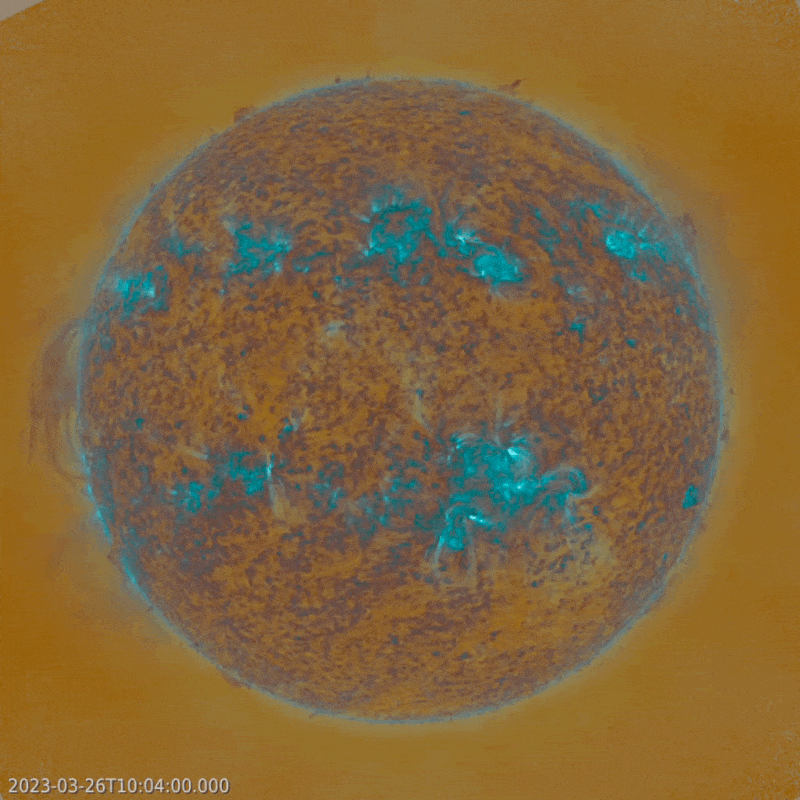
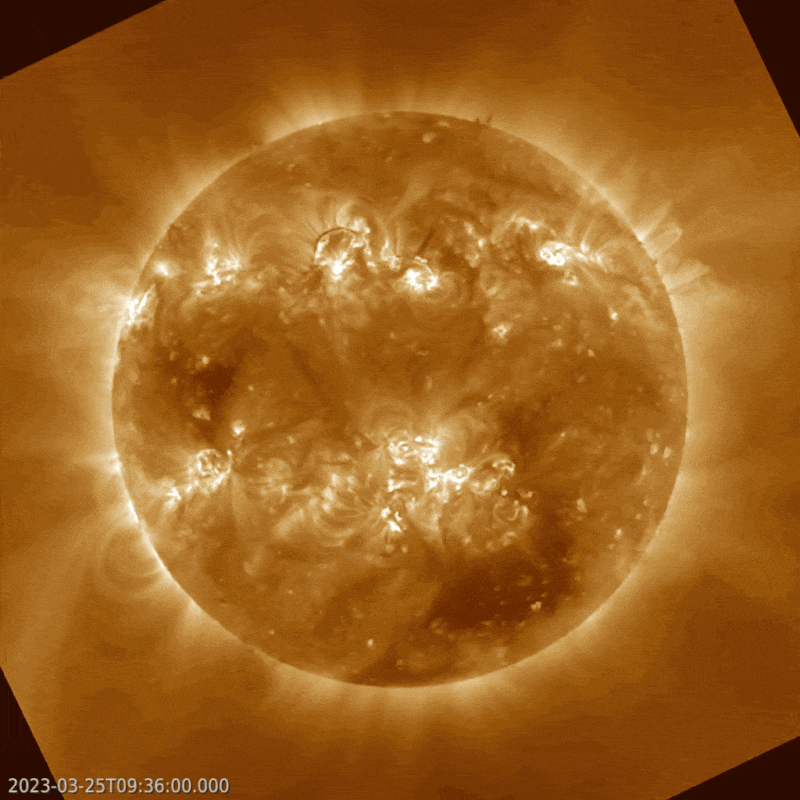
We had an awesome display of Northern Lights Sunday Night/Early Monday:
HOW LOW DID THE NORTHERN LIGHTS GO? A CME hit Earth's magnetic field on April 23rd, a direct hit that sparked a severe G4-class geomagnetic storm. Northern lights spilled out of the Arctic Circle all the way down to the US-Mexico border (+29.5N):
"I was out shooting the night sky in the Big Bend region of Texas when I saw the alerts of the severe geomagnetic storm," says photographer Brad Dwight. "I decided to point my camera north just to see if I could see anything. These pillars exploded into view."
Other notable low-latitude sightings in the USA include southern California (+32.5N), Arizona (+34.8N), Arkansas (+35.1 N), Colorado (+38N), Utah (+40.8N), Oklahoma (+36.3N), North Carolina (+36.2N), Tennessee (+35.4N), New Mexico (+35.9N) and Nebraska (+40.6N).
There were advantages to being a bit farther north. Consider this photo taken by Katie Korbuszewski of Helena, Montana (+46.5N):
"This was the first time I have seen Northern Lights," she says. "They became a bright dome right above my head and all around. You could visibly see cars and people in the gravel lot that had previously been obscured by darkness. I used my iPhone 12 mini on the night mode setting with an exposure of 3 seconds."
"I thank my dad Paul Korbuszewski, an avid astronomer who checks Spaceweather.com like one checks the NASDAQ," says Katie. "He gave me a call from Western Washington to tell me where to look!"
Did you miss the storm? Subscribers to our Space Weather Alert service received instant text messages when the CME arrived and when the subsequent storm erupted. Solar Cycle 25 is just getting started, so this will happen again. Make sure you don't miss the next storm!
Realtime Aurora Photo Gallery
Free:Spaceweather.com Newsletter
My son, Quinn sent me these images taken by somebody just northwest of our house in Evansville, IN. I'm in Detroit right now with my 97 year old dad. Skies were cloudy here.
You can get the latest Aurora forecast from these links:
https://www.swpc.noaa.gov/products/aurora-30-minute-forecast
My wife, Debbie and I got a free 10 day tour to Alaska in August of 1991 because I was the TV guest celebrity that the tour company used to sell the trip.
I got up in the middle of the night for over a week, in hopes of seeing something and got lucky on our last night outside of Anchorage, when we were staying at the Denali State Park(that rarely has clear skies).
Still extremely vivid images locked in my brain 32 years later!
Back then, there was no internet communication technology so it was extraordinarily lucky that we just happened to be in the very active part of solar cycle 22 in August 1991. Even though I was a meteorologist of 9 years, I had no information and didn't realize we were in Alaska near just after the latest peak (that only happens every 11 or so years (give or take a year+)until I was doing research using the internet many years later!
https://www.sciencealert.com/the-sun-is-way-more-active-than-official-solar-weather-predictions
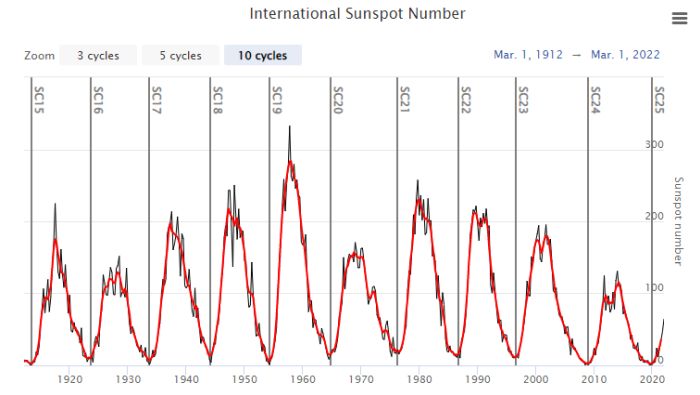
This is where we are right now in solar cycle 25. The sweet spot for seeing the Northern Lights for the next year+.
We have already exceeded the forecast and are about to exceed the previous peak from solar cycle 24 a decade ago, with still a year to go..... but that one was the weakest in 100 years.
Maybe we'll get close to the number from solar cycle 23, which was just less than 200?

This is one way to track the Northern Lights forecast for a longer range period.
We have a display coming up in the far northern tier of the US the next few nights.
Go to this link below"
https://services.swpc.noaa.gov/text/27-day-outlook.txt
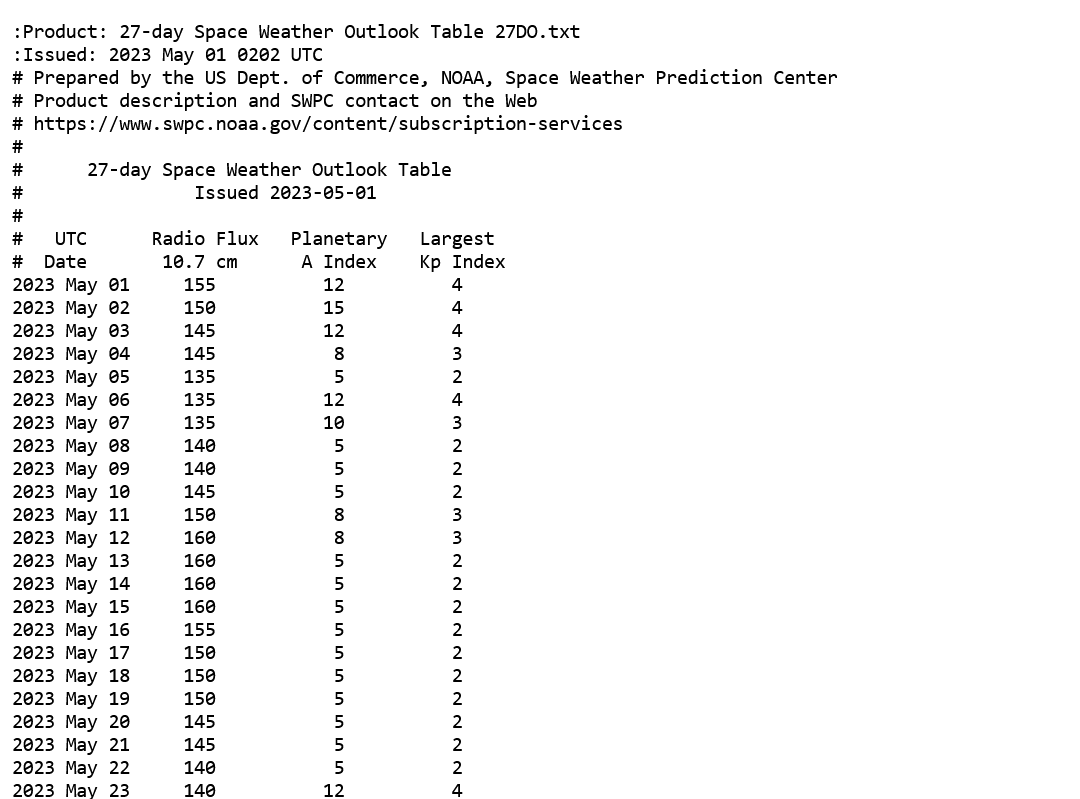
Compare the KP index with the colors on the maps at this link. KP4 is the yellow color on the maps.
These maps can't be copied here:
https://seetheaurora.com/kp-index-explained
The aurora should expand as far south as the yellow color(these predictions can be off by several shades-like the last one was).
So May 1-3, the auroras should be visible just south of the Canadian border if skies are clear. The farther north the observer, the stronger the impact from the energy traveling in the solar wind that was released days earlier by the sun, interacting with the earths magnetic field, which is strongest at the poles.
Geomagnetic Storms
https://www.swpc.noaa.gov/phenomena/geomagnetic-storms
+++++++
We know about the disturbances a couple days before they hit because we see them on the sun 8 minutes after they happen.
It takes light from the sun 8 minutes to go 93 million miles to reach the earth
https://phys.org/news/2013-04-sunlight-earth.html
https://www.pbs.org/seeinginthedark/astronomy-topics/light-as-a-cosmic-time-machine.html
But the solar wind ONLY travels at around 1 million miles per HOUR, which would mean around 93 hours to get to earth typically, which is almost 4 days(96 hours).
However, a disturbance or storm that ejects energy in the solar wind towards earth can accelerate the speed. The location on the sun makes a difference too.
The closer to the sun's equator, the slower the solar wind speed. Energy ejected from closer to the poles, results in the solar wind being faster.
https://en.wikipedia.org/wiki/Solar_wind
So the energy from an eruption can arrive in our magnetosphere in 3 days.
++++++++++++++
Shorter range forecast:
You can get the latest Aurora forecast from these links:
https://www.swpc.noaa.gov/products/aurora-30-minute-forecast
Unlike the previous forecast for aurora's that ended up with MORE than expected, this so far has been much LESS than expected.
Predicting space weather is MUCH less accurate than forecasting atmospheric weather!!!!
However, the number of sunspots has exceeded predictions for 26 months in a row!!
This may mean the peak is coming much sooner, even later this year, instead of 2024/25.
The 11 year sunspot cycle has ranged from 9 years to 14 years.
This would be one of the shortest ones.
https://link.springer.com/article/10.1007/s12210-022-01127-z
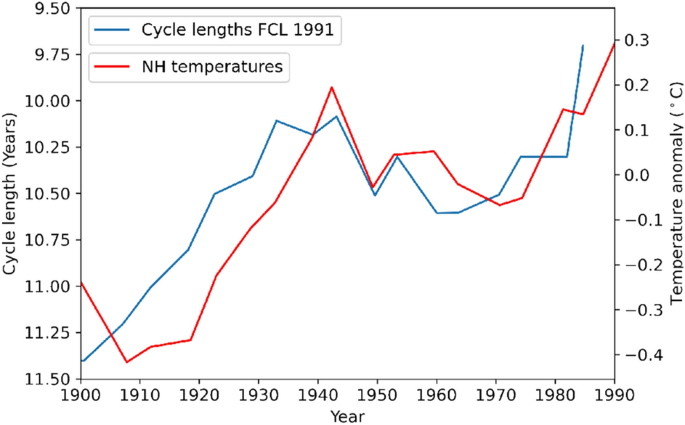
We have also reassessed the relation between the solar cycle length and the temperature on Earth using the most recent versions of the sunspot and Earth’s temperature datasets available. Our results suggest that the good correlation between the solar cycle length and the temperature on Earth found earlier breaks down when the entire record of reliable sunspot data (since 1740s) is considered. The previously reported agreement between the cycle length and the northern hemisphere temperatures on Earth appears to have been an artefact due to mainly two factors: (1) restricting the studied period to roughly 1870–1970, while the series diverge before and after that period and (2) arbitrarily estimating the date of the following extrema (instead of ignoring these data points) and in this way biasing upwards the cycle length series. The divergence of the series over the more recent years, which includes in principle higher quality data acquired in a more systematic way than in the past, precludes the divergence being an artefact of sunspot or temperature data.
https://ui.adsabs.harvard.edu/abs/2010GeoRL..37.6104D/abstract
Motivated by a prevailing view that a long minimum leads to a weak sunspot cycle,
++++++++++++
The long minimum that we experienced recently, caused most scientists to predict a very weak cycle 25.........and are WRONG so far.
I wish that I could remember to keep us updated on this because the remainder of 2023 has a good chance for some noteworthy events.
Solar wind
speed: 465.0 km/sec
density: 7.37 protons/cm3
Updated: Today at 0936 UT
Daily Sun: 15 May 23

Update 5-15-23: Sunspot AR3305 is in a state of turmoil, with sub-spots rapidly appearing and disappearing. These instabilities could lead to solar flare activity. Credit: SDO/HMI
A MINOR CME IS COMING: NOAA forecasters say that a CME could hit Earth's magnetic field on May 16th. Relatively faint and slow-moving, it was hurled into space on May 12th by an erupting filament of magnetism in the sun's southern hemisphere. No more than minor G1-class geomagnetic storms are expected. Aurora alerts: SMS Text.
MAGNETOMETERS ARE GETTING RESTLESS: Last week, solar activity was high. The sun hurled so many CMEs into space that scarcely a day went by without one hitting Earth. Stuart Green's magnetometer in Lancashire, England, recorded every impact:
"Our crackling sun released multiple minor CMEs over the past week," says Green. "Their geomagnetic effect was generally weak, but nevertheless sufficient to be detected on my magnetometer here in the UK. The constant 'drumbeat' of CMEs shows that Solar Cycle 25 is continuing to develop nicely."
Green built his own magnetometer from scratch. "The sensor is buried in my garden about 0.5 meters below ground in an East/West orientation," he explains. "This allows very sensitive (sub nanotesla) measurements of magnetic declination during geomagnetic storms."
MINOR CME IMPACT STILL POSSIBLE TODAY: NOAA forecasters say that a CME could hit Earth's magnetic field midday (UT) on May 16th. Relatively faint and slow-moving, it was hurled into space on May 12th by an erupting filament of magnetism in the sun's southern hemisphere. No more than minor G1-class geomagnetic storms are expected. Aurora alerts: SMS Text.
SOLAR FILAMENTS OUTNUMBER SUNSPOTS: If there is an explosion on the sun today, it might not come from a sunspot. Unstable magnetic filaments pose a greater threat. This photo from Michael Borman of Evansville, Indiana, shows at least 20 dark filaments scattered around the solar disk:
This means there are about three times more filaments than sunspot groups, with half-a-dozen directly facing Earth.
Famously unstable, solar filaments are twisted tubes of magnetism filled with dense plasma. Their eruptions can hurl massive CMEs into space. Sometimes the debris falls back to the surface of the sun, triggering a Hyder Flare; two explosions for the price of one. To illustrate the potency of these structures, the severe geomagnetic storm of April 23-24, 2023, was caused by a filament eruption, not a sunspot. Stay tuned. Solar flare alerts: SMS Text.
Canadian wildfires are creating a type of natural solar filter for observers in parts of North America. Thick smoke dims the setting sun, revealing sunspots that would normally be lost in the glare. Here are some examples from New Jersey, New York, Pennsylvania and Nebraska.
A NEW AND BIGGER STARLINK SATELLITE: On May 20th, Dan Bush of Albany, Missouri, watched in amazement as 22 newly-launched Starlink satellites passed over his backyard. "They flared incredibly brightly," says Bush, who recorded this video of sunlight glinting off their metallic bodies:
The flares were incredibly bright because they came from a new type of satellite--the Starlink V2 Mini. Ironically, these "Mini" satellites are much larger then their predecessors. Each Starlink V2 Mini weighs about 1,760 pounds, nearly three times heavier than older Starlinks. They are also much wider, with two solar panels spanning 100 ft tip-to-tip. Previous generations had a single solar array only 36 ft wide.
Improved phased array antennas on these new Starlinks have four times the communications capacity of earlier generations, and they are the next step in SpaceX's plans to beam high-speed internet directly to cell phones.
With the May 19th launch of these satellites from Cape Canaveral, SpaceX has deployed 4,469 Starlinks in all, including units no longer in service. More than 4,100 Starlink satellites are currently in orbit.
Realtime Aurora Photo Gallery
Free:
Spaceweather.com Newsletter